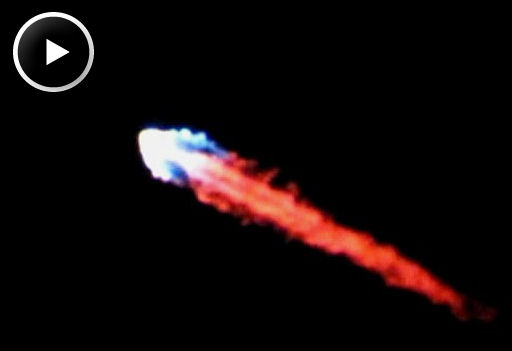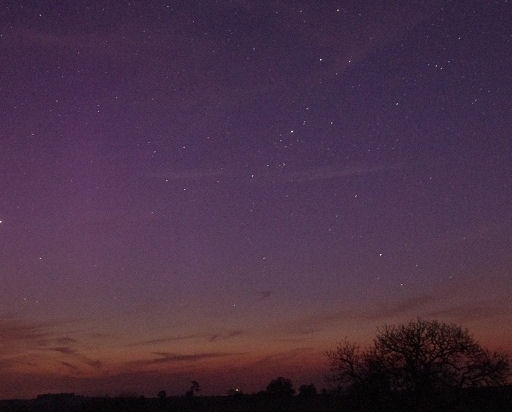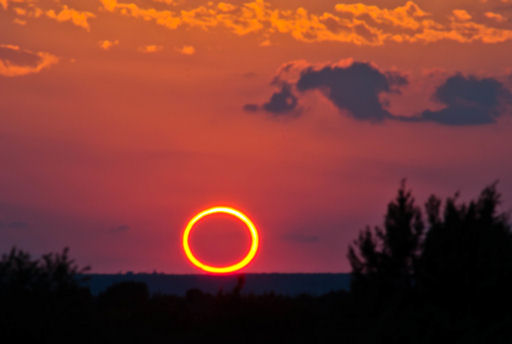QUIET SUN: With no sunspots actively flaring, the sun's x-ray output has flatlined. Solar activity is low, and likely to remain so for the next 24 hours.
DRAGON SIGHTINGS: NASA officials are calling it a turning point in space exploration. Yesterday, a commercial rocket, SpaceX's Falcon 9, blasted off from Cape Canaveral on a mission to re-supply the International Space Station. As the Falcon 9 roared into the sky, Brent of Orlando, Florida, photographed its fiery exhaust through his backyard telescope:
"What a neat launch!" he says. "I was able to see it from 60 miles away."
The rocket propelled SpaceX's Dragon spacecraft into orbit, where it is now chasing the ISS around Earth. Docking is expected on May 25th. The Dragon is carrying about 1,200 pounds of supplies (mainly food and clothing) for the crew of the station. The spacecraft can hold 7,300 pounds of material, but because this is a test flight, the manifest was limited.
Are you ready to see the Dragon? It is flying over North America during the hours before dawn. Check Space Weather's Simple Satellite Tracker or your cellphone for sighting opportunities.
PURPLE SKIES: Earth is entering a high-speed solar wind stream, and this is causing geomagnetic activity at high latitudes. First contact with the stream on May 22nd turned the sky over Cumbria, United Kingdom, deep purple:
"The sky was bright because of twilight, but we could still see these faint auroras," says photographer Jon Cooper.
So far the solar wind has not caused a full-fledged geomagnetic storm, but this could change during the next 24 hours. NOAA forecasters estimate a 15% to 20% chance of storms around the poles as the solar wind continues to blow. Aurora alerts: text, voice.
more images: from Darryl Van Gaal of Horwood Lake Lodge, Timmins, Ontario; from Horace Smith of Clinton County, Michigan, USA
FANTASTIC ECLIPSE: The Moon passed in front of the sun on Sunday, May 20th, producing a deep solar eclipse visible across the Pacific side of Earth. Sunlight dimmed, the air cooled, ordinary sunbeams turned into fat crescents and rings of light. And the sunset was definitely different. Jacob Thumberger sends this picture from Gail, Texas:
Many more pictures of the eclipse may be found in our new realtime photo gallery. It's an experimental service, so feel free to report problems. Start clicking for rings of fire:

![]()
Solar wind
speed: 587.9 km/sec
density: 0.1 protons/cm3
explanation | more data
Updated: Today at 1611 UT
![]()
X-ray Solar Flares
6-hr max: B7 1108 UT May23
24-hr: C1 0027 UT May23
explanation | more data
Updated: Today at: 1600 UT
![]()
![]()
![]()
Daily Sun: 23 May 12
![]()
![]()
None of the sunspots on the Earthside of the sun is actively flaring. Solar activity is low. Credit: SDO/HMI
![]()
![]()
![]()
Sunspot number: 95
What is the sunspot number?
Updated 22 May 2012
Spotless Days
Current Stretch: 0 days
2012 total: 0 days (0%)
2011 total: 2 days (<1%)
2010 total: 51 days (14%)
2009 total: 260 days (71%)
Since 2004: 821 days
Typical Solar Min: 486 days
Updated 22 May 2012
The Radio Sun
10.7 cm flux: 121 sfu
explanation | more data
Updated 22 May 2012
![]()
![]()
![]()
Current Auroral Oval:
![]()
Switch to: Europe, USA, New Zealand, Antarctica
Credit: NOAA/POES
![]()
![]()
![]()
Planetary K-index
Now: Kp= 2 quiet
24-hr max: Kp= 5 storm
explanation | more data
![]()
Interplanetary Mag. Field
Btotal: 3.7 nT
Bz: 0.2 nT north
explanation | more data
Updated: Today at 1616 UT
![]()
![]()
![]()
Coronal Holes: 23 May 12
![]()
![]()
There are no large coronal holes on the Earthside of the sun. Credit: SDO/AIA.







